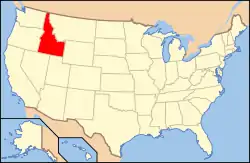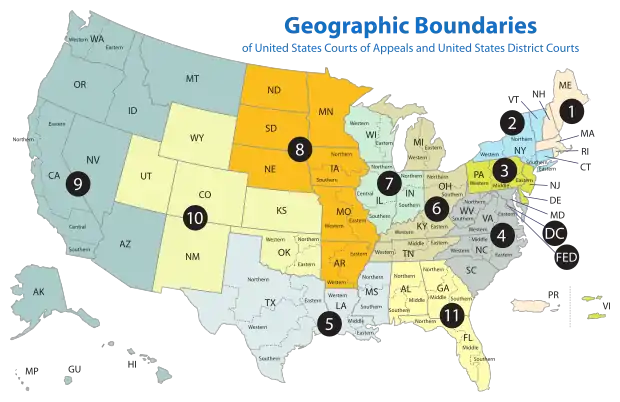United States District Court for the District of Idaho
The United States District Court for the District of Idaho (in case citations, D. Idaho) is the Federal district court whose jurisdiction comprises the state of Idaho (except for the part of the state within Yellowstone National Park, which is under the jurisdiction of the United States District Court for the District of Wyoming).[1][2] Court is held in Boise, Coeur d'Alene, and Pocatello. Cases from the District of Idaho are appealed to the United States Court of Appeals for the Ninth Circuit (except for patent claims and claims against the U.S. government under the Tucker Act, which are appealed to the Federal Circuit).
| United States District Court for the District of Idaho | |
|---|---|
| (D. Idaho) | |
 | |
| Location | Boise More locations |
| Appeals to | Ninth Circuit |
| Established | July 3, 1890 |
| Judges | 2 |
| Chief Judge | David Nye |
| Officers of the court | |
| U.S. Attorney | Bart Davis |
| U.S. Marshal | Brent R. Bunn |
| www | |
The United States Attorney's Office for the District of Idaho represents the United States in civil and criminal litigation in the court. The current U.S. Attorney for the District of Idaho is Bart Davis.
History
The District of Idaho was established shortly after Idaho's admission as a U.S. State. On July 3, 1890, by 26 Stat. 215, the United States Congress organized Idaho as one judicial district, authorizing one judgeship for the court and assigning it to the Ninth Circuit.[3] The second judgeship was authorized by Congress on February 10, 1954, by 68 Stat. 8.[3]
Current judges
As of January 2, 2019:
| # | Title | Judge | Duty station | Born | Term of service | Appointed by | ||
|---|---|---|---|---|---|---|---|---|
| Active | Chief | Senior | ||||||
| 12 | Chief Judge | David Nye | Pocatello | 1958 | 2017–present | 2019–present | — | Trump |
| 11 | District Judge | B. Lynn Winmill | Pocatello | 1952 | 1995–present | 1999–2019 | — | Clinton |
| 10 | Senior Judge | Edward Lodge | inactive | 1933 | 1989–2015 | 1992–1999 | 2015–present | G.H.W. Bush |
Vacancies and pending nominations
| Seat | Prior judge's duty station | Seat last held by | Reason for vacancy | Date of vacancy | Nominee | Date of nomination |
|---|---|---|---|---|---|---|
| 2 | Pocatello | B. Lynn Winmill | Senior status | August 16, 2021[4] | ― | ― |
Former judges
| # | Judge | State | Born–died | Active service | Chief Judge | Senior status | Appointed by | Reason for termination |
|---|---|---|---|---|---|---|---|---|
| 1 | James Helmick Beatty | ID | 1836–1927 | 1891–1907[Note 1] | — | — | B. Harrison | retirement |
| 2 | Frank Sigel Dietrich | ID | 1863–1930 | 1907–1927[Note 2] | — | — | T. Roosevelt | elevation to 9th Cir. |
| 3 | Charles Cheatham Cavanah | ID | 1871–1953 | 1927–1942 | — | 1942–1953 | Coolidge | death |
| 4 | Chase A. Clark | ID | 1883–1966 | 1943–1964 | 1954–1964 | 1964–1966 | F. Roosevelt | death |
| 5 | Fredrick Monroe Taylor | ID | 1901–1988 | 1954–1971 | 1964–1971 | 1971–1988 | Eisenhower | death |
| 6 | Raymond Clyne McNichols | ID | 1914–1985 | 1964–1981 | 1971–1981 | 1981–1985 | L. Johnson | death |
| 7 | J. Blaine Anderson | ID | 1922–1988 | 1971–1976 | — | — | Nixon | elevation to 9th Cir. |
| 8 | Marion Jones Callister | ID | 1921–1997 | 1976–1989 | 1981–1988 | 1989–1997 | Ford | death |
| 9 | Harold Lyman Ryan | ID | 1923–1995 | 1981–1992 | 1988–1992 | 1992–1995 | Reagan | death |
- Recess appointment; formally nominated on December 10, 1891, confirmed by the United States Senate on February 4, 1892, and received his commission the same day.
- Recess appointment; formally nominated on December 3, 1907, confirmed by the Senate on December 17, 1907, and received his commission the same day.
Chief judges
Chief judges have administrative responsibilities with respect to their district court. Unlike the Supreme Court, where one justice is specifically nominated to be chief, the office of chief judge rotates among the district court judges. To be chief, a judge must have been in active service on the court for at least one year, be under the age of 65, and have not previously served as chief judge. A vacancy is filled by the judge highest in seniority among the group of qualified judges. The chief judge serves for a term of seven years or until age 70, whichever occurs first. The age restrictions are waived if no members of the court would otherwise be qualified for the position.
When the office was created in 1948, the chief judge was the longest-serving judge who had not elected to retire on what has since 1958 been known as senior status or declined to serve as chief judge. After August 6, 1959, judges could not become or remain chief after turning 70 years old. The current rules have been in operation since October 1, 1982.
Succession of seats
|
|
| ||||||||||||||||||||||||||||||||||||||||
See also
Notes
- 28 U.S.C. § 92.
- 28 U.S.C. § 131.
- District of Idaho legislative history from the Federal Judicial Center.
- brussell@idahopress.com, BETSY Z. RUSSELL. "Eye on Boise: Judge Winmill to take senior status in August". Idaho Press. Retrieved 2021-01-24.
